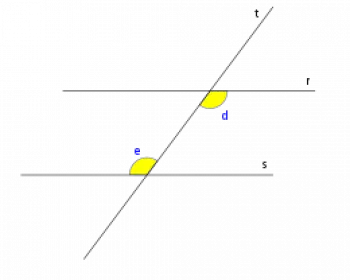
Alternate interior angles are a type of angle found at the intersection of two parallel lines cut by a transversal line. Alternate interior angles are those that lie on opposite sides of the transversal line and between the two parallel lines. These angles have the same measure and are congruent to each other.
If we have two parallel lines, call them L1 and L2, and a transversal line through them, then alternate interior angles are formed as follows:
-
Angle A, which is on one side of the transversal line and between the lines L1 and L2.
-
Angle B, which is on the opposite side of the transversal line and also between lines L1 and L2.
The key property of alternate interior angles is that they have the same measure, that is, they are congruent:
Angle A = Angle B
This means that if we know the value of one of the alternate interior angles, we can determine the measure of the other. Alternate interior angles are an important part of geometry and are used in problem solving and proofs involving parallel lines and transversals.
Practical applications
Alternate interior angles are useful in various applications in mathematics and in everyday life, especially when dealing with parallel lines and transversals. Some of the most common applications are:
-
Geometry: Alternate interior angles are an important property of parallel lines and transversals. They are used in solving geometric problems and in proving theorems related to the properties of parallel lines.
-
Educational Mathematics: Alternate interior angles are an important topic in mathematics education, especially in the teaching of geometry and trigonometry. They help students understand the relationships between angles and parallel lines.
-
Design of structures: In architecture and engineering design, it is essential to ensure the correct alignment of structural elements, such as beams, columns and walls. Alternate interior angles are considered when designing structures that require parallel and transversal lines.
-
Object placement: In interior design, alternate internal angles can be useful for placing objects equidistant from parallel lines, such as bookshelves, pictures, or furniture.
-
Design of streets and highways: In the planning and design of highways, engineers must consider the intersections and connections of parallel roads. Alternate internal angles are relevant to ensure proper traffic distribution and road safety.
-
Problem solving in navigation: Alternate internal angles can also be applied in navigation and in solving problems related to routes, distances and geographic locations.
Difference between alternate interior and exterior angles
Alternate interior angles and alternate exterior angles are two concepts related to geometry that occur when two parallel lines are cut by a transversal line.
Alternate interior angles lie on opposite sides of the transversal line, but inside the parallel lines. On the other hand, alternate exterior angles are also on opposite sides of the transversal line, but outside the parallel lines.
Both types of angles have similar characteristics: they have the same measure and are congruent to each other. That is, if we know the value of one alternate interior angle, then the other alternate interior angle will have the same measure. The same goes for alternate exterior angles.
In addition, both the internal and external ones play an important role in showing that the lines that form them are parallel. If we find that two alternate interior angles or two alternate exterior angles are congruent, then we can conclude that the corresponding lines are parallel.